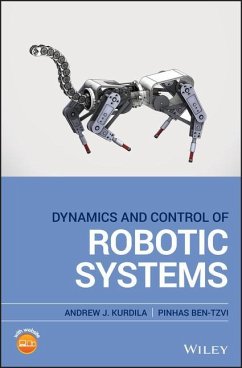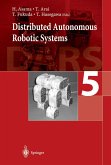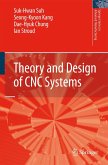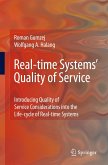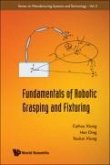- Gebundenes Buch
- Merkliste
- Auf die Merkliste
- Bewerten Bewerten
- Teilen
- Produkt teilen
- Produkterinnerung
- Produkterinnerung
A comprehensive review of the principles and dynamics of robotic systems Dynamics and Control of Robotic Systems offers a systematic and thorough theoretical background for the study of the dynamics and control of robotic systems. The authors--noted experts in the field--highlight the underlying principles of dynamics and control that can be employed in a variety of contemporary applications. The book contains a detailed presentation of the precepts of robotics and provides methodologies that are relevant to realistic robotic systems. The robotic systems represented include wide range examples…mehr
Andere Kunden interessierten sich auch für
![Nonrecursive Control Design for Nonlinear Systems Nonrecursive Control Design for Nonlinear Systems]() Chuanlin ZhangNonrecursive Control Design for Nonlinear Systems160,99 €
Chuanlin ZhangNonrecursive Control Design for Nonlinear Systems160,99 €![Distributed Autonomous Robotic Systems 5 Distributed Autonomous Robotic Systems 5]() Distributed Autonomous Robotic Systems 5112,99 €
Distributed Autonomous Robotic Systems 5112,99 €![Dynamics and Control of Structures Dynamics and Control of Structures]() Leonard MeirovitchDynamics and Control of Structures241,99 €
Leonard MeirovitchDynamics and Control of Structures241,99 €![Theory and Design of Cnc Systems Theory and Design of Cnc Systems]() Suk-Hwan SuhTheory and Design of Cnc Systems201,99 €
Suk-Hwan SuhTheory and Design of Cnc Systems201,99 €![Power Plant Control and Instrumentation: The Control of Boilers and Hrsg Systems Power Plant Control and Instrumentation: The Control of Boilers and Hrsg Systems]() David LindsleyPower Plant Control and Instrumentation: The Control of Boilers and Hrsg Systems148,99 €
David LindsleyPower Plant Control and Instrumentation: The Control of Boilers and Hrsg Systems148,99 €![Real-Time Systems' Quality of Service Real-Time Systems' Quality of Service]() Roman GumzejReal-Time Systems' Quality of Service81,99 €
Roman GumzejReal-Time Systems' Quality of Service81,99 €![Fundamentals of Robotic Grasping and Fixturing Fundamentals of Robotic Grasping and Fixturing]() Caihua XiongFundamentals of Robotic Grasping and Fixturing124,99 €
Caihua XiongFundamentals of Robotic Grasping and Fixturing124,99 €-
-
-
A comprehensive review of the principles and dynamics of robotic systems Dynamics and Control of Robotic Systems offers a systematic and thorough theoretical background for the study of the dynamics and control of robotic systems. The authors--noted experts in the field--highlight the underlying principles of dynamics and control that can be employed in a variety of contemporary applications. The book contains a detailed presentation of the precepts of robotics and provides methodologies that are relevant to realistic robotic systems. The robotic systems represented include wide range examples from classical industrial manipulators, humanoid robots to robotic surgical assistants, space vehicles, and computer controlled milling machines. The book puts the emphasis on the systematic application of the underlying principles and shows how the computational and analytical tools such as MATLAB, Mathematica, and Maple enable students to focus on robotics' principles and theory. Dynamics and Control of Robotic Systems contains an extensive collection of examples and problems and: * Puts the focus on the fundamentals of kinematics and dynamics as applied to robotic systems * Presents the techniques of analytical mechanics of robotics * Includes a review of advanced topics such as the recursive order N formulation * Contains a wide array of design and analysis problems for robotic systems Written for students of robotics, Dynamics and Control of Robotic Systems offers a comprehensive review of the underlying principles and methods of the science of robotics.
Hinweis: Dieser Artikel kann nur an eine deutsche Lieferadresse ausgeliefert werden.
Hinweis: Dieser Artikel kann nur an eine deutsche Lieferadresse ausgeliefert werden.
Produktdetails
- Produktdetails
- Verlag: Wiley
- Seitenzahl: 520
- Erscheinungstermin: 16. Dezember 2019
- Englisch
- Abmessung: 246mm x 170mm x 36mm
- Gewicht: 1039g
- ISBN-13: 9781119524830
- ISBN-10: 1119524830
- Artikelnr.: 55769870
- Herstellerkennzeichnung
- Libri GmbH
- Europaallee 1
- 36244 Bad Hersfeld
- gpsr@libri.de
- Verlag: Wiley
- Seitenzahl: 520
- Erscheinungstermin: 16. Dezember 2019
- Englisch
- Abmessung: 246mm x 170mm x 36mm
- Gewicht: 1039g
- ISBN-13: 9781119524830
- ISBN-10: 1119524830
- Artikelnr.: 55769870
- Herstellerkennzeichnung
- Libri GmbH
- Europaallee 1
- 36244 Bad Hersfeld
- gpsr@libri.de
ANDREW J. KURDILA, PHD, is the W. Martin Johnson Professor of Mechanical Engineering at Virginia Tech. He is the author of Structural Dynamics: An Introduction to Computer Methods from Wiley. PINHAS BEN-TZVI, PHD, is Associate Professor of Mechanical Engineering at Virginia Tech. He has expertise in robotics and autonomous systems, bio-inspired robotics, mechatronics, control systems, robotic vision, human-robot interaction, machine learning, and more.
Preface xiii
Acknowledgment xv
About the Companion Website xvii
1 Introduction 1
1.1 Motivation 1
1.2 Origins of Robotic Systems 5
1.3 General Structure of Robotic Systems 7
1.4 Robotic Manipulators 9
1.4.1 Typical Structure of Robotic Manipulators 9
1.4.2 Classification of Robotic Manipulators 11
1.4.2.1 Classification by Motion Characteristics 11
1.4.2.2 Classification by Degrees of Freedom 12
1.4.2.3 Classification by Driver Technology and Drive Power 12
1.4.2.4 Classification by Kinematic Structure 12
1.4.2.5 Classification by Workspace Geometry 14
1.4.3 Examples of Robotic Manipulators 14
1.4.3.1 Cartesian Robotic Manipulator 15
1.4.3.2 Cylindrical Robotic Manipulator 16
1.4.3.3 SCARA Robotic Manipulator 16
1.4.3.4 Spherical Robotic Manipulator 17
1.4.3.5 PUMA Robotic Manipulator 18
1.4.4 Spherical Wrist 18
1.4.5 Articulated Robot 20
1.5 Mobile Robotics 20
1.5.1 Humanoid Robots 20
1.5.2 Autonomous Ground Vehicles 22
1.5.3 Autonomous Air Vehicles 23
1.5.4 Autonomous Marine Vehicles 25
1.6 An Overview of Robotics Dynamics and Control Problems 26
1.6.1 Forward Kinematics 27
1.6.2 Inverse Kinematics 28
1.6.3 Forward Dynamics 28
1.6.4 Inverse Dynamics and Feedback Control 29
1.6.5 Dynamics and Control of Robotic Vehicles 30
1.7 Organization of the Book 31
1.8 Problems for Chapter 1 33
2 Fundamentals of Kinematics 35
2.1 Bases and Coordinate Systems 35
2.1.1 N-Tuples and M × N Arrays 35
2.1.2 Vectors, Bases and Frames 39
2.1.2.1 Vectors 40
2.1.2.2 Bases and Frames 41
2.2 Rotation Matrices 49
2.3 Parameterizations of Rotation Matrices 52
2.3.1 Single Axis Rotations 52
2.3.2 Cascades of Rotation Matrices 56
2.3.2.1 Cascade Rotations about Moving Axes 56
2.3.2.2 Cascade Rotations about Fixed Axes 57
2.3.3 Euler Angles 57
2.3.3.1 The 3-2-1 Yaw-Pitch-Roll Euler Angles 58
2.3.3.2 The 3-1-3 Precession-Nutation-Spin Euler Angles 62
2.3.4 Axis Angle Parameterization 65
2.4 Position, Velocity, and Acceleration 68
2.5 Angular Velocity and Angular Acceleration 77
2.5.1 Angular Velocity 77
2.5.2 Angular Acceleration 83
2.6 Theorems of Kinematics 84
2.6.1 Addition of Angular Velocities 84
2.6.2 Relative Velocity 87
2.6.3 Relative Acceleration 88
2.6.4 Common Coordinate Systems 91
2.6.4.1 Cartesian Coordinates 91
2.6.4.2 Cylindrical Coordinates 92
2.6.4.3 Spherical Coordinates 94
2.7 Problems for Chapter 2, Kinematics 96
2.7.1 Problems on N-tuples and M × N Arrays 96
2.7.2 Problems on Vectors, Bases, and Frames 97
2.7.3 Problems on Rotation Matrices 98
2.7.4 Problems on Position, Velocity, and Acceleration 102
2.7.5 Problems on Angular Velocity 104
2.7.6 Problems on the Theorems of Kinematics 104
2.7.6.1 Problems on the Addition of Angular Velocities 104
2.7.7 Problems on Relative Velocity and Acceleration 105
2.7.8 Problems on Common Coordinate Systems 108
3 Kinematics of Robotic Systems 109
3.1 Homogeneous Transformations and Rigid Motion 109
3.2 Ideal Joints 115
3.2.1 The Prismatic Joint 116
3.2.2 The Revolute Joint 117
3.2.3 Other Ideal Joints 119
3.3 The Denavit-Hartenberg Convention 121
3.3.1 Kinematic Chains and Numbering in the DH Convention 121
3.3.2 Definition of Frames in the DH Convention 123
3.3.3 Homogeneous Transforms in the DH Convention 124
3.3.4 The DH Procedure 127
3.3.5 Angular Velocity and Velocity in the DH Convention 133
3.4 Recursive O(N) Formulation of Forward Kinematics 138
3.4.1 Recursive Calculation of Velocity and Angular Velocity 140
3.4.2 Efficiency and Computational Cost 143
3.4.3 Recursive Calculation of Acceleration and Angular Acceleration 147
3.5 Inverse Kinematics 160
3.5.1 Solvability 160
3.5.2 Analytical Methods 163
3.5.2.1 Algebraic Methods 163
3.5.2.2 Geometric Methods 174
3.5.3 Optimization Methods 176
3.5.4 Inverse Velocity Kinematics 184
3.5.4.1 Singularity 185
3.6 Problems for Chapter 3, Kinematics of Robotic Systems 186
3.6.1 Problems on Homogeneous Transformations 186
3.6.2 Problems on Ideal Joints and Constraints 188
3.6.3 Problems on the DH Convention 188
3.6.4 Problems on Angular Velocity and Velocity for Kinematic Chains 190
3.6.5 Problems on Inverse Kinematics 195
4 Newton-Euler Formulations 197
4.1 Linear Momentum of Rigid Bodies 197
4.2 Angular Momentum of Rigid Bodies 203
4.2.1 First Principles 203
4.2.2 Angular Momentum and Inertia 208
4.2.3 Calculation of the Inertia Matrix 214
4.2.3.1 The Inertia Rotation Transformation Law 214
4.2.3.2 Principal Axes of Inertia 218
4.2.3.3 The Parallel Axis Theorem 221
4.2.3.4 Symmetry and Inertia 224
4.3 The Newton-Euler Equations 229
4.4 Euler's Equation for a Rigid Body 233
4.5 Equations of Motion for Mechanical Systems 235
4.5.1 The General Strategy 235
4.5.2 Free Body Diagrams 236
4.6 Structure of Governing Equations: Newton-Euler Formulations 258
4.6.1 Differential Algebraic Equations (DAEs) 258
4.6.2 Ordinary Differential Equations (ODEs) 260
4.7 Recursive Newton-Euler Formulations 262
4.8 Recursive Derivation of the Equations of Motion 271
4.9 Problems for Chapter 4, Newton-Euler Equations 274
4.9.1 Problems on Linear Momentum 274
4.9.2 Problems on the Center of Mass 277
4.9.3 Problems on the Inertia Matrix 279
4.9.4 Problems on Angular Momentum 281
4.9.5 Problems on the Newton-Euler Equations 282
5 Analytical Mechanics 285
5.1 Hamilton's Principle 285
5.1.1 Generalized Coordinates 285
5.1.2 Functionals and the Calculus of Variations 288
5.1.3 Hamilton's Principle for Conservative Systems 292
5.1.4 Kinetic Energy for Rigid Bodies 299
5.2 Lagrange's Equations for Conservative Systems 303
5.3 Hamilton's Extended Principle 307
5.3.1 Virtual Work Formulations 307
5.4 Lagrange's Equations for Robotic Systems 322
5.4.1 Natural Systems 322
5.4.2 Lagrange's Equations and the Denavit-Hartenberg Convention 326
5.5 Constrained Systems 329
5.6 Problems for Chapter 5, Analytical Mechanics 334
5.6.1 Problems on Hamilton's Principle 334
5.6.2 Problems on Lagrange's Equations 337
5.6.3 Problems on Hamilton's Extended Principle 339
5.6.4 Problems on Constrained Systems 345
6 Control of Robotic Systems 347
6.1 The Structure of Control Problems 347
6.1.1 Setpoint and Tracking Feedback Control Problems 348
6.1.2 Open Loop and Closed Loop Control 349
6.1.3 Linear and Nonlinear Control 349
6.2 Fundamentals of Stability Theory 350
6.3 Advanced Techniques of Stability Theory 357
6.4 Lyapunov's Direct Method 358
6.5 The Invariance Principle 361
6.6 Dynamic Inversion or Computed Torque Control 366
6.7 Approximate Dynamic Inversion and Uncertainty 376
6.8 Controllers Based on Passivity 389
6.9 Actuator Models 393
6.9.1 Electric Motors 393
6.9.2 Linear Actuators 400
6.10 Backstepping Control and Actuator Dynamics 404
6.11 Problems for Chapter 6, control of Robotic Systems 407
6.11.1 Problems on Gravity Compensation and PD Setpoint Control 407
6.11.2 Problems on Computed Torque Tracking Control 412
6.11.3 Problems on Dissipativity Based Tracking Control 413
7 Image Based Control of Robotic Systems 415
7.1 The Geometry of Camera Measurements 415
7.1.1 Perspective Projection and Pinhole Camera Models 415
7.1.2 Pixel Coordinates and CCD Cameras 418
7.1.3 The Interaction Matrix 419
7.2 Image Based Visual Servo Control 423
7.2.1 Control Synthesis and Closed Loop Equations 424
7.2.2 Calculation of Initial Conditions 427
7.3 Task Space Control 441
7.4 Task Space and Visual Control 447
7.5 Problems for Chapter 7 459
A Appendix 465
A.1 Fundamentals of Linear Algebra 465
A.1.1 Solution of Matrix Equations 467
A.1.2 Linear Independence and Rank 468
A.1.3 Invertibility and Rank 470
A.1.4 Least Squares Approximation 470
A.1.5 Rank Conditions and the Interaction Matrix 475
A.2 The Algebraic Eigenvalue Problem 475
A.2.1 Self-adjoint Matrices 476
A.2.2 Jordan Canonical Form 478
A.3 Gauss Transformations and LU Factorizations 479
References 485
Index 489
Acknowledgment xv
About the Companion Website xvii
1 Introduction 1
1.1 Motivation 1
1.2 Origins of Robotic Systems 5
1.3 General Structure of Robotic Systems 7
1.4 Robotic Manipulators 9
1.4.1 Typical Structure of Robotic Manipulators 9
1.4.2 Classification of Robotic Manipulators 11
1.4.2.1 Classification by Motion Characteristics 11
1.4.2.2 Classification by Degrees of Freedom 12
1.4.2.3 Classification by Driver Technology and Drive Power 12
1.4.2.4 Classification by Kinematic Structure 12
1.4.2.5 Classification by Workspace Geometry 14
1.4.3 Examples of Robotic Manipulators 14
1.4.3.1 Cartesian Robotic Manipulator 15
1.4.3.2 Cylindrical Robotic Manipulator 16
1.4.3.3 SCARA Robotic Manipulator 16
1.4.3.4 Spherical Robotic Manipulator 17
1.4.3.5 PUMA Robotic Manipulator 18
1.4.4 Spherical Wrist 18
1.4.5 Articulated Robot 20
1.5 Mobile Robotics 20
1.5.1 Humanoid Robots 20
1.5.2 Autonomous Ground Vehicles 22
1.5.3 Autonomous Air Vehicles 23
1.5.4 Autonomous Marine Vehicles 25
1.6 An Overview of Robotics Dynamics and Control Problems 26
1.6.1 Forward Kinematics 27
1.6.2 Inverse Kinematics 28
1.6.3 Forward Dynamics 28
1.6.4 Inverse Dynamics and Feedback Control 29
1.6.5 Dynamics and Control of Robotic Vehicles 30
1.7 Organization of the Book 31
1.8 Problems for Chapter 1 33
2 Fundamentals of Kinematics 35
2.1 Bases and Coordinate Systems 35
2.1.1 N-Tuples and M × N Arrays 35
2.1.2 Vectors, Bases and Frames 39
2.1.2.1 Vectors 40
2.1.2.2 Bases and Frames 41
2.2 Rotation Matrices 49
2.3 Parameterizations of Rotation Matrices 52
2.3.1 Single Axis Rotations 52
2.3.2 Cascades of Rotation Matrices 56
2.3.2.1 Cascade Rotations about Moving Axes 56
2.3.2.2 Cascade Rotations about Fixed Axes 57
2.3.3 Euler Angles 57
2.3.3.1 The 3-2-1 Yaw-Pitch-Roll Euler Angles 58
2.3.3.2 The 3-1-3 Precession-Nutation-Spin Euler Angles 62
2.3.4 Axis Angle Parameterization 65
2.4 Position, Velocity, and Acceleration 68
2.5 Angular Velocity and Angular Acceleration 77
2.5.1 Angular Velocity 77
2.5.2 Angular Acceleration 83
2.6 Theorems of Kinematics 84
2.6.1 Addition of Angular Velocities 84
2.6.2 Relative Velocity 87
2.6.3 Relative Acceleration 88
2.6.4 Common Coordinate Systems 91
2.6.4.1 Cartesian Coordinates 91
2.6.4.2 Cylindrical Coordinates 92
2.6.4.3 Spherical Coordinates 94
2.7 Problems for Chapter 2, Kinematics 96
2.7.1 Problems on N-tuples and M × N Arrays 96
2.7.2 Problems on Vectors, Bases, and Frames 97
2.7.3 Problems on Rotation Matrices 98
2.7.4 Problems on Position, Velocity, and Acceleration 102
2.7.5 Problems on Angular Velocity 104
2.7.6 Problems on the Theorems of Kinematics 104
2.7.6.1 Problems on the Addition of Angular Velocities 104
2.7.7 Problems on Relative Velocity and Acceleration 105
2.7.8 Problems on Common Coordinate Systems 108
3 Kinematics of Robotic Systems 109
3.1 Homogeneous Transformations and Rigid Motion 109
3.2 Ideal Joints 115
3.2.1 The Prismatic Joint 116
3.2.2 The Revolute Joint 117
3.2.3 Other Ideal Joints 119
3.3 The Denavit-Hartenberg Convention 121
3.3.1 Kinematic Chains and Numbering in the DH Convention 121
3.3.2 Definition of Frames in the DH Convention 123
3.3.3 Homogeneous Transforms in the DH Convention 124
3.3.4 The DH Procedure 127
3.3.5 Angular Velocity and Velocity in the DH Convention 133
3.4 Recursive O(N) Formulation of Forward Kinematics 138
3.4.1 Recursive Calculation of Velocity and Angular Velocity 140
3.4.2 Efficiency and Computational Cost 143
3.4.3 Recursive Calculation of Acceleration and Angular Acceleration 147
3.5 Inverse Kinematics 160
3.5.1 Solvability 160
3.5.2 Analytical Methods 163
3.5.2.1 Algebraic Methods 163
3.5.2.2 Geometric Methods 174
3.5.3 Optimization Methods 176
3.5.4 Inverse Velocity Kinematics 184
3.5.4.1 Singularity 185
3.6 Problems for Chapter 3, Kinematics of Robotic Systems 186
3.6.1 Problems on Homogeneous Transformations 186
3.6.2 Problems on Ideal Joints and Constraints 188
3.6.3 Problems on the DH Convention 188
3.6.4 Problems on Angular Velocity and Velocity for Kinematic Chains 190
3.6.5 Problems on Inverse Kinematics 195
4 Newton-Euler Formulations 197
4.1 Linear Momentum of Rigid Bodies 197
4.2 Angular Momentum of Rigid Bodies 203
4.2.1 First Principles 203
4.2.2 Angular Momentum and Inertia 208
4.2.3 Calculation of the Inertia Matrix 214
4.2.3.1 The Inertia Rotation Transformation Law 214
4.2.3.2 Principal Axes of Inertia 218
4.2.3.3 The Parallel Axis Theorem 221
4.2.3.4 Symmetry and Inertia 224
4.3 The Newton-Euler Equations 229
4.4 Euler's Equation for a Rigid Body 233
4.5 Equations of Motion for Mechanical Systems 235
4.5.1 The General Strategy 235
4.5.2 Free Body Diagrams 236
4.6 Structure of Governing Equations: Newton-Euler Formulations 258
4.6.1 Differential Algebraic Equations (DAEs) 258
4.6.2 Ordinary Differential Equations (ODEs) 260
4.7 Recursive Newton-Euler Formulations 262
4.8 Recursive Derivation of the Equations of Motion 271
4.9 Problems for Chapter 4, Newton-Euler Equations 274
4.9.1 Problems on Linear Momentum 274
4.9.2 Problems on the Center of Mass 277
4.9.3 Problems on the Inertia Matrix 279
4.9.4 Problems on Angular Momentum 281
4.9.5 Problems on the Newton-Euler Equations 282
5 Analytical Mechanics 285
5.1 Hamilton's Principle 285
5.1.1 Generalized Coordinates 285
5.1.2 Functionals and the Calculus of Variations 288
5.1.3 Hamilton's Principle for Conservative Systems 292
5.1.4 Kinetic Energy for Rigid Bodies 299
5.2 Lagrange's Equations for Conservative Systems 303
5.3 Hamilton's Extended Principle 307
5.3.1 Virtual Work Formulations 307
5.4 Lagrange's Equations for Robotic Systems 322
5.4.1 Natural Systems 322
5.4.2 Lagrange's Equations and the Denavit-Hartenberg Convention 326
5.5 Constrained Systems 329
5.6 Problems for Chapter 5, Analytical Mechanics 334
5.6.1 Problems on Hamilton's Principle 334
5.6.2 Problems on Lagrange's Equations 337
5.6.3 Problems on Hamilton's Extended Principle 339
5.6.4 Problems on Constrained Systems 345
6 Control of Robotic Systems 347
6.1 The Structure of Control Problems 347
6.1.1 Setpoint and Tracking Feedback Control Problems 348
6.1.2 Open Loop and Closed Loop Control 349
6.1.3 Linear and Nonlinear Control 349
6.2 Fundamentals of Stability Theory 350
6.3 Advanced Techniques of Stability Theory 357
6.4 Lyapunov's Direct Method 358
6.5 The Invariance Principle 361
6.6 Dynamic Inversion or Computed Torque Control 366
6.7 Approximate Dynamic Inversion and Uncertainty 376
6.8 Controllers Based on Passivity 389
6.9 Actuator Models 393
6.9.1 Electric Motors 393
6.9.2 Linear Actuators 400
6.10 Backstepping Control and Actuator Dynamics 404
6.11 Problems for Chapter 6, control of Robotic Systems 407
6.11.1 Problems on Gravity Compensation and PD Setpoint Control 407
6.11.2 Problems on Computed Torque Tracking Control 412
6.11.3 Problems on Dissipativity Based Tracking Control 413
7 Image Based Control of Robotic Systems 415
7.1 The Geometry of Camera Measurements 415
7.1.1 Perspective Projection and Pinhole Camera Models 415
7.1.2 Pixel Coordinates and CCD Cameras 418
7.1.3 The Interaction Matrix 419
7.2 Image Based Visual Servo Control 423
7.2.1 Control Synthesis and Closed Loop Equations 424
7.2.2 Calculation of Initial Conditions 427
7.3 Task Space Control 441
7.4 Task Space and Visual Control 447
7.5 Problems for Chapter 7 459
A Appendix 465
A.1 Fundamentals of Linear Algebra 465
A.1.1 Solution of Matrix Equations 467
A.1.2 Linear Independence and Rank 468
A.1.3 Invertibility and Rank 470
A.1.4 Least Squares Approximation 470
A.1.5 Rank Conditions and the Interaction Matrix 475
A.2 The Algebraic Eigenvalue Problem 475
A.2.1 Self-adjoint Matrices 476
A.2.2 Jordan Canonical Form 478
A.3 Gauss Transformations and LU Factorizations 479
References 485
Index 489
Preface xiii
Acknowledgment xv
About the Companion Website xvii
1 Introduction 1
1.1 Motivation 1
1.2 Origins of Robotic Systems 5
1.3 General Structure of Robotic Systems 7
1.4 Robotic Manipulators 9
1.4.1 Typical Structure of Robotic Manipulators 9
1.4.2 Classification of Robotic Manipulators 11
1.4.2.1 Classification by Motion Characteristics 11
1.4.2.2 Classification by Degrees of Freedom 12
1.4.2.3 Classification by Driver Technology and Drive Power 12
1.4.2.4 Classification by Kinematic Structure 12
1.4.2.5 Classification by Workspace Geometry 14
1.4.3 Examples of Robotic Manipulators 14
1.4.3.1 Cartesian Robotic Manipulator 15
1.4.3.2 Cylindrical Robotic Manipulator 16
1.4.3.3 SCARA Robotic Manipulator 16
1.4.3.4 Spherical Robotic Manipulator 17
1.4.3.5 PUMA Robotic Manipulator 18
1.4.4 Spherical Wrist 18
1.4.5 Articulated Robot 20
1.5 Mobile Robotics 20
1.5.1 Humanoid Robots 20
1.5.2 Autonomous Ground Vehicles 22
1.5.3 Autonomous Air Vehicles 23
1.5.4 Autonomous Marine Vehicles 25
1.6 An Overview of Robotics Dynamics and Control Problems 26
1.6.1 Forward Kinematics 27
1.6.2 Inverse Kinematics 28
1.6.3 Forward Dynamics 28
1.6.4 Inverse Dynamics and Feedback Control 29
1.6.5 Dynamics and Control of Robotic Vehicles 30
1.7 Organization of the Book 31
1.8 Problems for Chapter 1 33
2 Fundamentals of Kinematics 35
2.1 Bases and Coordinate Systems 35
2.1.1 N-Tuples and M × N Arrays 35
2.1.2 Vectors, Bases and Frames 39
2.1.2.1 Vectors 40
2.1.2.2 Bases and Frames 41
2.2 Rotation Matrices 49
2.3 Parameterizations of Rotation Matrices 52
2.3.1 Single Axis Rotations 52
2.3.2 Cascades of Rotation Matrices 56
2.3.2.1 Cascade Rotations about Moving Axes 56
2.3.2.2 Cascade Rotations about Fixed Axes 57
2.3.3 Euler Angles 57
2.3.3.1 The 3-2-1 Yaw-Pitch-Roll Euler Angles 58
2.3.3.2 The 3-1-3 Precession-Nutation-Spin Euler Angles 62
2.3.4 Axis Angle Parameterization 65
2.4 Position, Velocity, and Acceleration 68
2.5 Angular Velocity and Angular Acceleration 77
2.5.1 Angular Velocity 77
2.5.2 Angular Acceleration 83
2.6 Theorems of Kinematics 84
2.6.1 Addition of Angular Velocities 84
2.6.2 Relative Velocity 87
2.6.3 Relative Acceleration 88
2.6.4 Common Coordinate Systems 91
2.6.4.1 Cartesian Coordinates 91
2.6.4.2 Cylindrical Coordinates 92
2.6.4.3 Spherical Coordinates 94
2.7 Problems for Chapter 2, Kinematics 96
2.7.1 Problems on N-tuples and M × N Arrays 96
2.7.2 Problems on Vectors, Bases, and Frames 97
2.7.3 Problems on Rotation Matrices 98
2.7.4 Problems on Position, Velocity, and Acceleration 102
2.7.5 Problems on Angular Velocity 104
2.7.6 Problems on the Theorems of Kinematics 104
2.7.6.1 Problems on the Addition of Angular Velocities 104
2.7.7 Problems on Relative Velocity and Acceleration 105
2.7.8 Problems on Common Coordinate Systems 108
3 Kinematics of Robotic Systems 109
3.1 Homogeneous Transformations and Rigid Motion 109
3.2 Ideal Joints 115
3.2.1 The Prismatic Joint 116
3.2.2 The Revolute Joint 117
3.2.3 Other Ideal Joints 119
3.3 The Denavit-Hartenberg Convention 121
3.3.1 Kinematic Chains and Numbering in the DH Convention 121
3.3.2 Definition of Frames in the DH Convention 123
3.3.3 Homogeneous Transforms in the DH Convention 124
3.3.4 The DH Procedure 127
3.3.5 Angular Velocity and Velocity in the DH Convention 133
3.4 Recursive O(N) Formulation of Forward Kinematics 138
3.4.1 Recursive Calculation of Velocity and Angular Velocity 140
3.4.2 Efficiency and Computational Cost 143
3.4.3 Recursive Calculation of Acceleration and Angular Acceleration 147
3.5 Inverse Kinematics 160
3.5.1 Solvability 160
3.5.2 Analytical Methods 163
3.5.2.1 Algebraic Methods 163
3.5.2.2 Geometric Methods 174
3.5.3 Optimization Methods 176
3.5.4 Inverse Velocity Kinematics 184
3.5.4.1 Singularity 185
3.6 Problems for Chapter 3, Kinematics of Robotic Systems 186
3.6.1 Problems on Homogeneous Transformations 186
3.6.2 Problems on Ideal Joints and Constraints 188
3.6.3 Problems on the DH Convention 188
3.6.4 Problems on Angular Velocity and Velocity for Kinematic Chains 190
3.6.5 Problems on Inverse Kinematics 195
4 Newton-Euler Formulations 197
4.1 Linear Momentum of Rigid Bodies 197
4.2 Angular Momentum of Rigid Bodies 203
4.2.1 First Principles 203
4.2.2 Angular Momentum and Inertia 208
4.2.3 Calculation of the Inertia Matrix 214
4.2.3.1 The Inertia Rotation Transformation Law 214
4.2.3.2 Principal Axes of Inertia 218
4.2.3.3 The Parallel Axis Theorem 221
4.2.3.4 Symmetry and Inertia 224
4.3 The Newton-Euler Equations 229
4.4 Euler's Equation for a Rigid Body 233
4.5 Equations of Motion for Mechanical Systems 235
4.5.1 The General Strategy 235
4.5.2 Free Body Diagrams 236
4.6 Structure of Governing Equations: Newton-Euler Formulations 258
4.6.1 Differential Algebraic Equations (DAEs) 258
4.6.2 Ordinary Differential Equations (ODEs) 260
4.7 Recursive Newton-Euler Formulations 262
4.8 Recursive Derivation of the Equations of Motion 271
4.9 Problems for Chapter 4, Newton-Euler Equations 274
4.9.1 Problems on Linear Momentum 274
4.9.2 Problems on the Center of Mass 277
4.9.3 Problems on the Inertia Matrix 279
4.9.4 Problems on Angular Momentum 281
4.9.5 Problems on the Newton-Euler Equations 282
5 Analytical Mechanics 285
5.1 Hamilton's Principle 285
5.1.1 Generalized Coordinates 285
5.1.2 Functionals and the Calculus of Variations 288
5.1.3 Hamilton's Principle for Conservative Systems 292
5.1.4 Kinetic Energy for Rigid Bodies 299
5.2 Lagrange's Equations for Conservative Systems 303
5.3 Hamilton's Extended Principle 307
5.3.1 Virtual Work Formulations 307
5.4 Lagrange's Equations for Robotic Systems 322
5.4.1 Natural Systems 322
5.4.2 Lagrange's Equations and the Denavit-Hartenberg Convention 326
5.5 Constrained Systems 329
5.6 Problems for Chapter 5, Analytical Mechanics 334
5.6.1 Problems on Hamilton's Principle 334
5.6.2 Problems on Lagrange's Equations 337
5.6.3 Problems on Hamilton's Extended Principle 339
5.6.4 Problems on Constrained Systems 345
6 Control of Robotic Systems 347
6.1 The Structure of Control Problems 347
6.1.1 Setpoint and Tracking Feedback Control Problems 348
6.1.2 Open Loop and Closed Loop Control 349
6.1.3 Linear and Nonlinear Control 349
6.2 Fundamentals of Stability Theory 350
6.3 Advanced Techniques of Stability Theory 357
6.4 Lyapunov's Direct Method 358
6.5 The Invariance Principle 361
6.6 Dynamic Inversion or Computed Torque Control 366
6.7 Approximate Dynamic Inversion and Uncertainty 376
6.8 Controllers Based on Passivity 389
6.9 Actuator Models 393
6.9.1 Electric Motors 393
6.9.2 Linear Actuators 400
6.10 Backstepping Control and Actuator Dynamics 404
6.11 Problems for Chapter 6, control of Robotic Systems 407
6.11.1 Problems on Gravity Compensation and PD Setpoint Control 407
6.11.2 Problems on Computed Torque Tracking Control 412
6.11.3 Problems on Dissipativity Based Tracking Control 413
7 Image Based Control of Robotic Systems 415
7.1 The Geometry of Camera Measurements 415
7.1.1 Perspective Projection and Pinhole Camera Models 415
7.1.2 Pixel Coordinates and CCD Cameras 418
7.1.3 The Interaction Matrix 419
7.2 Image Based Visual Servo Control 423
7.2.1 Control Synthesis and Closed Loop Equations 424
7.2.2 Calculation of Initial Conditions 427
7.3 Task Space Control 441
7.4 Task Space and Visual Control 447
7.5 Problems for Chapter 7 459
A Appendix 465
A.1 Fundamentals of Linear Algebra 465
A.1.1 Solution of Matrix Equations 467
A.1.2 Linear Independence and Rank 468
A.1.3 Invertibility and Rank 470
A.1.4 Least Squares Approximation 470
A.1.5 Rank Conditions and the Interaction Matrix 475
A.2 The Algebraic Eigenvalue Problem 475
A.2.1 Self-adjoint Matrices 476
A.2.2 Jordan Canonical Form 478
A.3 Gauss Transformations and LU Factorizations 479
References 485
Index 489
Acknowledgment xv
About the Companion Website xvii
1 Introduction 1
1.1 Motivation 1
1.2 Origins of Robotic Systems 5
1.3 General Structure of Robotic Systems 7
1.4 Robotic Manipulators 9
1.4.1 Typical Structure of Robotic Manipulators 9
1.4.2 Classification of Robotic Manipulators 11
1.4.2.1 Classification by Motion Characteristics 11
1.4.2.2 Classification by Degrees of Freedom 12
1.4.2.3 Classification by Driver Technology and Drive Power 12
1.4.2.4 Classification by Kinematic Structure 12
1.4.2.5 Classification by Workspace Geometry 14
1.4.3 Examples of Robotic Manipulators 14
1.4.3.1 Cartesian Robotic Manipulator 15
1.4.3.2 Cylindrical Robotic Manipulator 16
1.4.3.3 SCARA Robotic Manipulator 16
1.4.3.4 Spherical Robotic Manipulator 17
1.4.3.5 PUMA Robotic Manipulator 18
1.4.4 Spherical Wrist 18
1.4.5 Articulated Robot 20
1.5 Mobile Robotics 20
1.5.1 Humanoid Robots 20
1.5.2 Autonomous Ground Vehicles 22
1.5.3 Autonomous Air Vehicles 23
1.5.4 Autonomous Marine Vehicles 25
1.6 An Overview of Robotics Dynamics and Control Problems 26
1.6.1 Forward Kinematics 27
1.6.2 Inverse Kinematics 28
1.6.3 Forward Dynamics 28
1.6.4 Inverse Dynamics and Feedback Control 29
1.6.5 Dynamics and Control of Robotic Vehicles 30
1.7 Organization of the Book 31
1.8 Problems for Chapter 1 33
2 Fundamentals of Kinematics 35
2.1 Bases and Coordinate Systems 35
2.1.1 N-Tuples and M × N Arrays 35
2.1.2 Vectors, Bases and Frames 39
2.1.2.1 Vectors 40
2.1.2.2 Bases and Frames 41
2.2 Rotation Matrices 49
2.3 Parameterizations of Rotation Matrices 52
2.3.1 Single Axis Rotations 52
2.3.2 Cascades of Rotation Matrices 56
2.3.2.1 Cascade Rotations about Moving Axes 56
2.3.2.2 Cascade Rotations about Fixed Axes 57
2.3.3 Euler Angles 57
2.3.3.1 The 3-2-1 Yaw-Pitch-Roll Euler Angles 58
2.3.3.2 The 3-1-3 Precession-Nutation-Spin Euler Angles 62
2.3.4 Axis Angle Parameterization 65
2.4 Position, Velocity, and Acceleration 68
2.5 Angular Velocity and Angular Acceleration 77
2.5.1 Angular Velocity 77
2.5.2 Angular Acceleration 83
2.6 Theorems of Kinematics 84
2.6.1 Addition of Angular Velocities 84
2.6.2 Relative Velocity 87
2.6.3 Relative Acceleration 88
2.6.4 Common Coordinate Systems 91
2.6.4.1 Cartesian Coordinates 91
2.6.4.2 Cylindrical Coordinates 92
2.6.4.3 Spherical Coordinates 94
2.7 Problems for Chapter 2, Kinematics 96
2.7.1 Problems on N-tuples and M × N Arrays 96
2.7.2 Problems on Vectors, Bases, and Frames 97
2.7.3 Problems on Rotation Matrices 98
2.7.4 Problems on Position, Velocity, and Acceleration 102
2.7.5 Problems on Angular Velocity 104
2.7.6 Problems on the Theorems of Kinematics 104
2.7.6.1 Problems on the Addition of Angular Velocities 104
2.7.7 Problems on Relative Velocity and Acceleration 105
2.7.8 Problems on Common Coordinate Systems 108
3 Kinematics of Robotic Systems 109
3.1 Homogeneous Transformations and Rigid Motion 109
3.2 Ideal Joints 115
3.2.1 The Prismatic Joint 116
3.2.2 The Revolute Joint 117
3.2.3 Other Ideal Joints 119
3.3 The Denavit-Hartenberg Convention 121
3.3.1 Kinematic Chains and Numbering in the DH Convention 121
3.3.2 Definition of Frames in the DH Convention 123
3.3.3 Homogeneous Transforms in the DH Convention 124
3.3.4 The DH Procedure 127
3.3.5 Angular Velocity and Velocity in the DH Convention 133
3.4 Recursive O(N) Formulation of Forward Kinematics 138
3.4.1 Recursive Calculation of Velocity and Angular Velocity 140
3.4.2 Efficiency and Computational Cost 143
3.4.3 Recursive Calculation of Acceleration and Angular Acceleration 147
3.5 Inverse Kinematics 160
3.5.1 Solvability 160
3.5.2 Analytical Methods 163
3.5.2.1 Algebraic Methods 163
3.5.2.2 Geometric Methods 174
3.5.3 Optimization Methods 176
3.5.4 Inverse Velocity Kinematics 184
3.5.4.1 Singularity 185
3.6 Problems for Chapter 3, Kinematics of Robotic Systems 186
3.6.1 Problems on Homogeneous Transformations 186
3.6.2 Problems on Ideal Joints and Constraints 188
3.6.3 Problems on the DH Convention 188
3.6.4 Problems on Angular Velocity and Velocity for Kinematic Chains 190
3.6.5 Problems on Inverse Kinematics 195
4 Newton-Euler Formulations 197
4.1 Linear Momentum of Rigid Bodies 197
4.2 Angular Momentum of Rigid Bodies 203
4.2.1 First Principles 203
4.2.2 Angular Momentum and Inertia 208
4.2.3 Calculation of the Inertia Matrix 214
4.2.3.1 The Inertia Rotation Transformation Law 214
4.2.3.2 Principal Axes of Inertia 218
4.2.3.3 The Parallel Axis Theorem 221
4.2.3.4 Symmetry and Inertia 224
4.3 The Newton-Euler Equations 229
4.4 Euler's Equation for a Rigid Body 233
4.5 Equations of Motion for Mechanical Systems 235
4.5.1 The General Strategy 235
4.5.2 Free Body Diagrams 236
4.6 Structure of Governing Equations: Newton-Euler Formulations 258
4.6.1 Differential Algebraic Equations (DAEs) 258
4.6.2 Ordinary Differential Equations (ODEs) 260
4.7 Recursive Newton-Euler Formulations 262
4.8 Recursive Derivation of the Equations of Motion 271
4.9 Problems for Chapter 4, Newton-Euler Equations 274
4.9.1 Problems on Linear Momentum 274
4.9.2 Problems on the Center of Mass 277
4.9.3 Problems on the Inertia Matrix 279
4.9.4 Problems on Angular Momentum 281
4.9.5 Problems on the Newton-Euler Equations 282
5 Analytical Mechanics 285
5.1 Hamilton's Principle 285
5.1.1 Generalized Coordinates 285
5.1.2 Functionals and the Calculus of Variations 288
5.1.3 Hamilton's Principle for Conservative Systems 292
5.1.4 Kinetic Energy for Rigid Bodies 299
5.2 Lagrange's Equations for Conservative Systems 303
5.3 Hamilton's Extended Principle 307
5.3.1 Virtual Work Formulations 307
5.4 Lagrange's Equations for Robotic Systems 322
5.4.1 Natural Systems 322
5.4.2 Lagrange's Equations and the Denavit-Hartenberg Convention 326
5.5 Constrained Systems 329
5.6 Problems for Chapter 5, Analytical Mechanics 334
5.6.1 Problems on Hamilton's Principle 334
5.6.2 Problems on Lagrange's Equations 337
5.6.3 Problems on Hamilton's Extended Principle 339
5.6.4 Problems on Constrained Systems 345
6 Control of Robotic Systems 347
6.1 The Structure of Control Problems 347
6.1.1 Setpoint and Tracking Feedback Control Problems 348
6.1.2 Open Loop and Closed Loop Control 349
6.1.3 Linear and Nonlinear Control 349
6.2 Fundamentals of Stability Theory 350
6.3 Advanced Techniques of Stability Theory 357
6.4 Lyapunov's Direct Method 358
6.5 The Invariance Principle 361
6.6 Dynamic Inversion or Computed Torque Control 366
6.7 Approximate Dynamic Inversion and Uncertainty 376
6.8 Controllers Based on Passivity 389
6.9 Actuator Models 393
6.9.1 Electric Motors 393
6.9.2 Linear Actuators 400
6.10 Backstepping Control and Actuator Dynamics 404
6.11 Problems for Chapter 6, control of Robotic Systems 407
6.11.1 Problems on Gravity Compensation and PD Setpoint Control 407
6.11.2 Problems on Computed Torque Tracking Control 412
6.11.3 Problems on Dissipativity Based Tracking Control 413
7 Image Based Control of Robotic Systems 415
7.1 The Geometry of Camera Measurements 415
7.1.1 Perspective Projection and Pinhole Camera Models 415
7.1.2 Pixel Coordinates and CCD Cameras 418
7.1.3 The Interaction Matrix 419
7.2 Image Based Visual Servo Control 423
7.2.1 Control Synthesis and Closed Loop Equations 424
7.2.2 Calculation of Initial Conditions 427
7.3 Task Space Control 441
7.4 Task Space and Visual Control 447
7.5 Problems for Chapter 7 459
A Appendix 465
A.1 Fundamentals of Linear Algebra 465
A.1.1 Solution of Matrix Equations 467
A.1.2 Linear Independence and Rank 468
A.1.3 Invertibility and Rank 470
A.1.4 Least Squares Approximation 470
A.1.5 Rank Conditions and the Interaction Matrix 475
A.2 The Algebraic Eigenvalue Problem 475
A.2.1 Self-adjoint Matrices 476
A.2.2 Jordan Canonical Form 478
A.3 Gauss Transformations and LU Factorizations 479
References 485
Index 489

